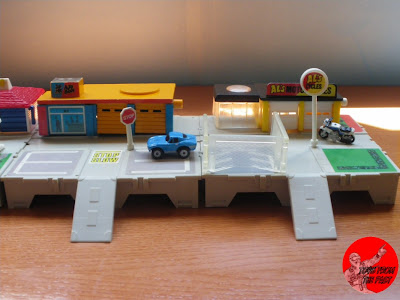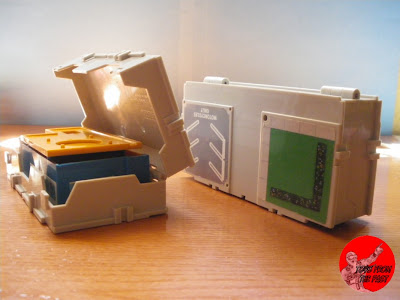
This article and the next one will deal with the travel city playsets from Micro Machines that I currently own. This time I’ll show two of them, and tomorrow, the next two.
These playsets are relatively rare to find, at least in Europe. Maybe they didn’t sell as expected, or maybe children preferred bigger playsets, like that one that turned into a van (Super Van City, 1994) or the one that turned into a toolbox (Super City Toolbox, 1988). The fact is that these are great toys, and since they were portable and fitted most pockets, it was great to carry anywhere to play with. In America, they were sold for approximately 5,50 to 6,00 US$. In Spain, as far as I can remember, they were sold between 900 and 1000 pesetas (5,50 to 6 Euros approx.).
The advantage of these sets, in comparison to the above mentioned Super City sets, is that you could combine your city “parts” as you wanted. Each base included some pegs at the sides that allowed you to insert them within the pegs of another base, so each time the city was different.
This first two are the Body Shop and the Cycle Shop. As you can see in the last picture, all components could be kept inside of the box, so no parts could be lost. There was additional room for 3-4 cars in each box.
The car that is depicted in each picture is the one that came with the playset. All the cars I know that had been included in these boxes were also available in normal sets, so if you had bad luck, you could get a car doubled.
There were 3 series made, the first one came out in 1987 (with the start of the line), and consisted of 12 different boxes, in 1988, the collection was expanded with 3 new playsets, and in 1989, 6 more were added to the travel city. Although they were still part of the catalogue in 1990, no new playsets were made. Those was probably just the rest of the previous three years what they were selling.

The first of these two playsets is the Body Shop, a blue building with two garages. This was my first set, and I had it before the line was officially launched in Spain, since my father bought it abroad (in Paris, France). It’s a relatively simple playset with just 4 pieces (building, doors, roof and stop-sign), plus the (always included) two ramps. The car which was included was a blue Chevrolet Corvette from 1963, also known als “Stingray”.

The second playset is the Cycle Shop, a little more complicated set with 9 pieces. It came with a motorbike which seems to be a Honda CR750.

Check two more playsets here!
As a bonus, I include an old catalogue picture for the Travel City Playsets. It was taken from the Christmas' toy catalogue from Galerías Preciados (1990, Spain)

FACTS and FIGURES:
- Name: TRAVEL CITY PLAYSETS: BODY SHOP and CYCLE SHOP
- Toy Line: Micro Machines
- Year: 1988 and 1989
- Company: Galoob (U.S.A.)
- Size of the vehicles: Approx. 1,5’’ or 2 cm
- Size of the playset: 12 cm x 12 cm


.jpg)
.jpg)
.jpg)
.jpg)
.jpg)
.jpg)

.jpg)

